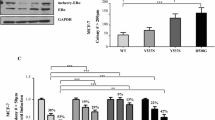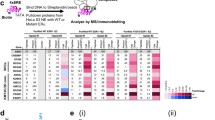Abstract
Background
The action of the steroid hormone estradiol (E2) is mediated via interaction with a specific receptor (ER) that initiates a series of events downstream, leading to the modulation of hormone-responsive genes and cell proliferation. Antihormones also bind, but do not confer the active configuration to ER, thereby, blocking the transmission of E2-ER-initiated signals for cell proliferation. Although these compounds qualify for successful therapy of ER-positive [ER (+)] breast cancer patients, only a fraction of patients responds to antihormone treatment. In this study, the functional status of ER is determined to identify alternative targets for therapy of antihormone-resistant ER (+) breast cancers.
Method
The interaction of ER with a specific DNA sequence, designated as E2 response element (ERE), was targeted to assess the functional state of ER. ER-ERE complex formation was measured by electrophoretic mobility shift assay (EMSA) and by a newly developed technique, based on the preferential binding of DNA-protein complex to a nitrocellulose membrane (NMBA) that measures both total and functional fraction of ER.
Results
The NMBA assay identified functional variants of ER among ER (+) breast cancer cell lines and breast tumor biopsy specimens. ER of (21PT) cells did not bind E2 and these cells were tamoxifen (TAM) resistant. However 21PT cells were sensitive to a calmodulin (CaM) antagonist, W7, that blocked ERE-ER complex formation.
Conclusions
ER variants of the 21PT type were detected among breast cancer biopsy specimens, emphasizing the significance of an alternative therapeutic target for TAM-resistant ER (+) human breast cancers with compounds such as W7.




Similar content being viewed by others
References
Jensen EV. (1981) Hormone dependency in breast cancer. Breast Cancer Res. Treat. 26: 2319–2326.
Jordan VC. (1992) The strategic use of antiestrogens to control the development and growth of breast cancer. Cancer 70: 977–982.
Hortobagy GN. (1998) Treatment of breast cancer. N. Eng. J. Med. 339: 974–984.
Lazennec G, Katzenellenbogen BS. (1999) Expression of human estrogen receptor using an efficient adenoviral gene delivery system is able to restore hormone dependent features to estrogen receptor-negative breast carcinoma cells. Mol. Cell Endocrionol. 149: 93–105.
Lazennec G, Alcorn JL, Katzenellenbogen BS. (1999) Adenovirus-mediated delivery of dominant negative estrogen receptor gene abrogates estrogen stimulated gene expression and breast cancer cell proliferation. Mol. Endocrinol. 13: 969–980.
Smith DF, Toft DO. (1993) Steroid receptors and their associated proteins. Mol. Endocrinol. 7: 4–11.
Kumar V, Chambon P. (1988) The estrogen receptor binds tightly to its response element as a ligand-induced homodimer. Cell 55: 145–156.
Tsai S-Y, Tsai M-J., O’Malley BW. (1989) Cooperative binding of steroid hormone receptors contributes to transcriptional synergism at target enhancer elements. Cell 57: 443–448.
Brown M. (1994) Estrogen receptor molecular biology. Hemat. Oncol. Clin. N. Amer. 8: 101–112.
Jordan VC. (1995) Studies on the estrogen receptor in breast cancer, 20 years as target for the treatment and prevention of cancer. Breast Cancer Res. Treat. 36: 267–285.
Shibata H, Spencer TE, Sergio AO, et al. (1997) Role of co-activators and co-repressors in the mechanism of steroid/thyroid receptor action. Recent Prog. Hormone Res. 52: 141–165.
Smith CL, Conneely M, O’Malley BW. (1993) Modulation of the ligand-independent activation of the human estrogen receptor by hormone and antihormone. Proc. Natl. Acad. Sci. USA 90: 6120–24.
Osborne CK. (1991) Receptors In Breast Diseases, In Breast Cancer and Diseases. Harris JR, Hellerman S, Henderson IC, Kinne DW (eds.). 2nd Edition, Lippincott, Philadelphia, pp. 301–325.
Hedden A, Muller V, Jensen EV. (1995) A new interpretation of antiestrogen action. NY Acad. Sci. 761: 109–120.
Paige LA, Christensen DJ, Gron H, et al. (1999) Estrogen receptor (ER) modulators each induce distinct conformational changes in ER α and ER β. Proc. Natl. Acad. Sci. USA 96: 3999–4004.
Love RR, Mazess RB, Barden HS, et al. (1992) Effects of tamoxifen on bone mineral density in postmenopausal women with breast cancer. N. Engl. J. Med. 326: 852–856.
Kedar RP, Bourne TH, Powles TJ, et al. (1994) Effects of tamoxifen on uterus and ovaries of postmenopausal women in a randomized breast cancer prevention trial. Lancet 343: 1318–1321.
Biswas DK, Cruz AP, Gansberger E, Pardee AB. (2000) Epidermal growth factor-induced nuclear factor κB activation: a major pathway of cell cycle progression in estrogen-receptor negative breast cancer cells. Proc. Natl. Acad. Sci. USA 97: 8542–8547.
Skaar TC, Prasad SC, Sharareh S, Lippman ME, Brunner N, Clarke R. (1998) Two dimensional gel electrophoresis analysis identify nucleoplasmin as an estrogen regulated protein associated with acquired estrogen-independence in human breast cancer cells. J. Steroid Chem. 67: 391–402.
Biswas DK, Cruz A, Pardee AB. (2000) Detection of estrogen receptor functional variants in human breast cancers by a novel approach. Biotechniques (In Press).
Sager R, Sheng S, Anisowicz A, et al. (1994) RNA genetics of breast cancer: maspin as paradigm. Cold Spring Harbor Symp. Quant. Biol. LIX: 537–546
Zajchowski DA, Band V, Trask DK, Kling D, Connolly, JL, Sager R. (1990) Suppression of tumor-forming ability and related traits in MCF-7 human breast cancer cells by fusion with mammary epithelial cells. Proc. Natl. Acad. Sci. USA 87: 2314–2318.
Biswas DK, Averboukh L, Sheng S, et al. (1998) Classification of breast cancer cells on the basis of a functional assay for estrogen receptor. Mol. Med. 4: 454–467.
Biswas DK, Reddy PV, Pickard M, Makkad B, Pettit N, Pardee AB. (1998) Calmodulin is essential for estrogen receptor interaction with its motif and activation of responsive promoter. J. Biol. Chem. 273: 33817–33824.
Dignam JD, Lebovitz RM, Roeder RD. (1983) Accurate transcription initiation by RNA polymerase II in a soluble extract from isolated mammalian nuclei. Nucleic Acids Res. 11: 1475–1489.
Bradford MM. (1978) A rapid sensitive method for the quantitation of microgram quantities of protein utilizing the principle of protein dye binding. Anal. Biochem. 72: 248–254.
Porter W, Wang F, Wang W, Duan R, Safe S. (1996) Role of estrogen receptor/Sp1 complexes in estrogen-induced heat shock protein 27 gene expression. Mol. Endocrinol. 11: 1371–1378.
Sukovich DA, Kukherjee R, Benfield, PA. (1994) A novel cell-type specific mechanism for estrogen receptor mediated gene activation in the absence of estrogen-responsive element. Mol. Cell Biol. 14: 7134–7143.
Pegram MD, Pauletti G, Slamon DJ. (1998) HER2/neu as a predictive marker of response to breast cancer therapy. Breast Cancer Res. Treat. 52: 155–167.
Hayes AJ, Li LY, Lippman ME. (1999) Science, medicine and the future. Brit. Med. 318: 853–856.
Mosman T. (1983) Rapid colorimetric assay for cellular growth and survival: application to proliferation and cytotoxic assay. J. Immunol. Meth. 65: 55–64.
Obourn JD, Koszewski NJ, Notides AC. (1993) Hormone- and DNA binding mechanisms of the recombinant human estrogen receptor. Biochemistry 32: 6229–6236.
Acknowledgments
The work was supported by funds from the Commonwealth of Massachusetts, Department of Public Health and Breast Cancer Research Grants Program and National Institutes of Health NCI Grant CA61253-07.
Author information
Authors and Affiliations
Corresponding author
Additional information
Communicated by AB Pardee.
Rights and permissions
About this article
Cite this article
Biswas, D.K., Cruz, A., Pettit, N. et al. A Therapeutic Target for Hormone-independent Estrogen Receptor-positive Breast Cancers. Mol Med 7, 59–67 (2001). https://doi.org/10.1007/BF03401839
Accepted:
Published:
Issue Date:
DOI: https://doi.org/10.1007/BF03401839




